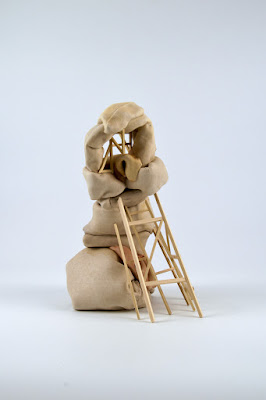All is not as it seems in
Shelter, Da Vinci Art Alliance's current collaboration with the Philadelphia Sculptors group. The exhibition takes viewers on a volatile journey that calls the very possibility of "shelter" into question.
Right off the bat, Sara Allen Prigodich's porcelain and wood constructions are so tactile and flesh-like that they evoke a morbid fascination, as if you're looking at a cadaver. Piled into lumps on top of their wooden frames, they resemble empty rolls of skin, beginning to go gray and flabby. In particular,
For Now, which positions the folds of flesh atop slender wooden stilts with all the solidity of cheap chopsticks, is breathtakingly creepy. If this work is about shelter, it's surely about the idea of shelter being unsustainable, fragile.
 |
| Sarah Allen Prigodich, “For Now,” Porcelain, oxides, wood, tarp, 9″ x 11″ x 6,” Da Vinci Art Alliance, 2018. |
Behind Prigodich's works hang Monica Kane's haunting multimedia wall sculptures, which combine steel and canvas with acetate reproductions of official United States naturalization documentation and certificates. Sober portraits of naturalized immigrants peer out against a rust-colored ground, framed by snippets of the elaborate typed text that means they are now Americans. Yet Kane's works don't have a celebratory air to them. The forbidding, spiky forms to which the portraits are affixed take on the air of prison guard towers, easily recalling the United States' still-ongoing imprisonment of refugees and migrants -- the decided lack of shelter for those who need it most.
Hanging nearby, George Lorio's
Flood, is a refreshingly elegant composition that uses color and texture sparingly to depict a white house sinking below a sheet of black water. While depicting one natural disaster,
Flood actually visually recalls another famous example: that of Dorothy's Kansas farmhouse twisting in a tornado. In Lorio's work, there is no shelter, no safety to be had, not in the world of fictional Midwestern twisters, or in real-life floods like the one that Houston experienced only a year ago.
 |
| George Lorio, “Flood,” Da Vinci Art Alliance, 2018. |
The most striking and thought-provoking work in
Shelter is Constance McBride's
Truth From Within. A prostrate human figure about two-thirds life size is built from cracked and jagged layers of ceramics stitched together with wire. Walking around the sculpture, one notices that the figure's skull has been cracked open and the top of its head is missing entirely; the emptiness inside has been left a burned-out gray-black color. The pose of the figure recalls prayer, but judging by the utter disrepair of the body -- skin sloughing off, the lower body connected to the torso with mean-looking loops of black wire -- prayer has proven not to be enough.
Truth From Within asks whether faith and prayer can be an adequate form of shelter, or whether they serve merely as a bandaid for endless suffering.
 |
| Constance McBride, “Truth From Within,” Da Vinci Art Alliance, 2018. |
At first glance, Uta Fellechner's
Lost Childhood takes a formal cue from Egyptian death masks -- appearing to honor and revere a deceased child. But a closer look at the face rendered in white and rust-shaded clay reveals decidedly more grown-up features. So the work asks: is growing up a form of death? Do we die inside, just a little, when we leave the safety, innocence, and shelter of childhood behind? Fellechner's other work in
Shelter,
Lost at the Border, also deals with childhood, albeit in a far less subtle way. Evoking an automatic pull of sympathy for the imagined child whose miniature teddy bear is cast aside on a hunk of wood, it doesn't exactly come across as an original motif.
Two works by Cindy Lu use gold and silver mylar emergency blankets to further address the themes of shelter and safety. When do mylar blankets appear in our lives? We get them from people who want to calm us down, to put an end to our hysteria and fear. Notably, Lu's
Play, consisting of simple toys -- a stuffed rabbit, a soccer ball, a jump rope -- asks whether childhood itself is a security blanket of sorts, whether we use nostalgia for an imagined past as a way of comforting us and distracting us from an undesirable presence.
 |
| Cindy Lu, “Play,” Da Vinci Art Alliance, 2018. |
Even in the darkest moments of
Shelter, there are specks of hope to be found. Chelsea Nader's
Open your doors and let down your walls and
Where she told me use a mottled, printed cloth to form miniature chairs, rugs, and doors. The cloth itself looks burned, blackened, and sooty, but refashioning that fabric into representations of useful, everyday items, suggests a kind of rebirth and renewal that can come when everything seems lost. Amy Puccio's
Knock-Knock, located near the door to the gallery, is a work whose relative positivity or negativity probably depends on what you're feeling when you take it in. Made out of wood and other mixed media, this wall sculpture takes the form of a sliding door lock with the chain slack, the knob paused on its journey. Is the lock opening or closing? Are we being let in, or shut out?




Comments
Post a Comment